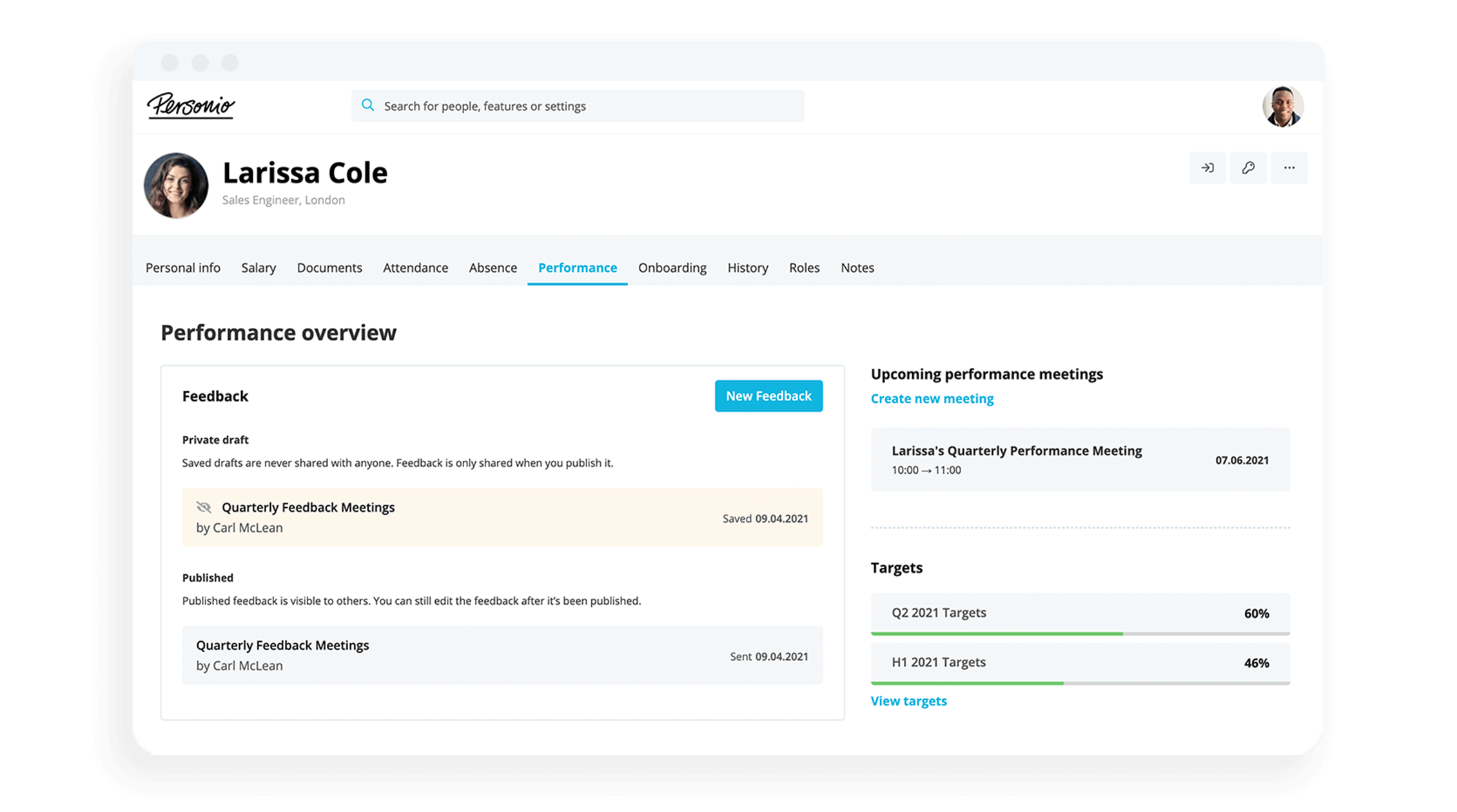
Streamline Your Feedback Cycles
Exchange fair, actionable feedback, company-wide.
Transform Your Feedback CyclesLatest Blog Posts
14 Types of Feedback: The Collected Guide

There's a type of feedback for every employee. But, with a wealth of options, which do you have on hand and which do you choose? In this guide, we offer our rundown of the most important types of feedback (and when to use them).
Chronicle all your employee feedback in one place: Personio.The Role of Effective Feedback
Top talent shouldn’t be left waiting for recognition. That’s why employee feedback, and the different types of feedback, is so crucial. It rewards talent with the tools to get better at what they do, and the transparency to know just how they are performing in their role.
But, what constitutes ‘good’ or even ‘great’ feedback? We know that feedback is a verbal response from colleagues, managers, customers, or subordinates that provides an assessment of actions, behaviours, or attitudes.
And, therein lies the point. Feedback is at its best when it is embedded in a workplace and becomes part of the working culture. In fact, many organisations aspire to have a feedback-driven culture, but it is easier said than done.
But, before we can design and encourage that culture, we need to know the different types of feedback at play. Here is our collection of the ones you need to know…
The Key Types of Feedback: Collected
What follows is our guide to the top types of feedback in no particular order:
Informal Feedback
Informal feedback is unscheduled and often unexpected. There is no formal process or procedure to initiate or govern this feedback, it’s not part of a regular cycle and, in some cases, it can be unwarranted or unwelcome.
Examples of informal feedback include: Approaching an employee out of the blue to tell them they’ve done a good job, providing suggestions for improvement, shouting at them, or berating them. It can come in all sorts of forms.
Informal feedback is not necessarily bad: Sometimes it can be very helpful to get or give feedback immediately because it’s fresh in everyone’s mind.
If people have the right attitude to giving feedback, this informal communication method can help improve employee relationships and help HR.
Formal (Formalised) Feedback
Formal feedback is a key element of core HR processes. Formal feedback mechanisms can be part of a performance management cycle and can take the form of staff appraisals, or development reviews (PDRs).
The key here is the word ‘formal’: In this instance, feedback is structured, usually pre-planned, and may involve reviewing metrics. It usually requires pre-preparation and often includes both feedback and feed-forward (advice given, to help employees improve their future behaviour).
Therefore, the feedback process itself is ‘formalized,’ and ideally, the way feedback is provided would be, too. That might mean sharing a way to offer feedback company-wide so that employees are providing feedback in a consistent fashion (more on that later).
The reason formal feedback methods used to conduct employee performance appraisals should be consistent is because they form the basis for salary and promotion reviews, goal-setting and may even help with employee retention and employee engagement.
Formative Feedback
This type of feedback is given during a process. Rather than waiting until the end of a project, year or cycle. It is used as a helpful way to explain how things are going at the time.
Conducting formative feedback during a project can help keep it on track. This principle underpins a lot of agile working methodologies.
Remember: During formative feedback sessions, it’s important to both provide feedback, respond to it, and encourage others to share their feedback as honestly as possible.
Ensure Fair, Constructive Feedback

Standardise your performance appraisals for all employees. Create customised feedback forms and rating scales you can use to improve performance, company-wide.
Transform Your Feedback CyclesSummative Feedback
This type of feedback is given at the end of a process or cycle such as the financial year-end, thecalendar year-end, the end of a project, or the end of someone’s employment. It is the opposite of formative feedback.
A project autopsy is effectively built on the idea of summative feedback. Stakeholders can go through what they felt working on a project, how things could be improved, and key learnings everyone can take with them.
Regular Feedback
Providing feedback often is very important. Research shows that team members who have regular meetings with their managers are three times more likely to be engaged at work compared to those who do not. The same applies to giving and receiving regular feedback.
Irregular Feedback
The opposite of regular feedback, irregular feedback happens infrequently or randomly.
Self-Feedback (Self-Appraisals)
Some companies require employees to conduct a self-appraisal during their formal review process. Employees can learn a lot from self-appraisals, although their responses may vary widely: (Either by over- or under-estimating their achievements). It’s important to review self-feedback and openly discuss its accuracy.
Run self-appraisals across your org with Personio’s HR software.
Peer Feedback (360º Feedback)
When colleagues (rather than managers) provide feedback this is referred to as peer feedback. It is often used as part of a 360-degree review.
Positive Feedback
The type of feedback that we all like to hear the most is positive feedback. This means we’re doing a good job and people are happy with our work.
Positive feedback can include praise, appreciation, and recognition. Employee engagement metrics trend three times higher for those employees who receive recognition, according to one large international study.
Negative Feedback
We’re less likely to enjoy receiving negative feedback but, while feedback can be negative (for example, we might be told we’re doing something wrong), it can also be constructive. Employees have to face criticism to get better at their jobs.
When feedback is regular, appropriate, relevant, focused on actions rather than personal attributes, target- or goal-based, and presented with minimal emotional attachment, even negative feedback can be useful (for example, to help employees’ career progression).
Constructive Feedback
The goal of constructive feedback is to help employees develop their skills while creating a more empowered, positive workforce of people who enjoy doing their jobs.
Constructive feedback can be provided based on a formal or informal evaluation.
When giving constructive feedback, it helps to explain what the recipient did well, didn’t do well, and what they could learn from their errors.
It should be followed up with relevant suggestions for improvement. This may include coaching (using the GROW model, for example), participation in an employee training program, or external studying as part of their professional development.
When constructive feedback is done well it can even boost employee motivation.
Destructive Feedback
The opposite of constructive feedback is destructive feedback. This is to be avoided at all costs. It demotivates employees, is likely to reduce employee retention, and increase staff turnover rates. Destructive feedback is often used by bullies, power-hungry managers, or those who dislike their employees. It is more common in toxic work environments.
Positive Feed-Forward
While the words sound like antonyms, feed-forward is not the opposite of feedback, it is a specific type of feedback. Often, feed-forward is used to encourage employees. It can come as a result of positive or constructive feedback.
The difference is: Feed-forward is about helping employees understand what they can do in the future, rather than focusing on past actions. Positive feed-forward can encourage employees to keep doing what they’re doing (if they’re doing it well), encourage them to help others learn from their behaviour, or focus on how they can change something to improve in the future.
Negative Feed-Forward
Giving negative feed-forward doesn’t have to be destructive. Focusing on what employees can do differently in the future can actually be very constructive. It can help them change behaviour, or warn them how to behave differently in certain circumstances – for example, in front of a particular client, or when dealing with a difficult colleague.
Ensure Fair, Constructive Feedback

Standardise your performance appraisals for all employees. Create customised feedback forms and rating scales you can use to improve performance, company-wide.
Transform Your Feedback CyclesHow Should HR Teams Manage Different Feedback Types?
Feedback is a key part of employee relations, the company’s approach to creating and maintaining positive relationships with, and between, employees. Studies show that having positive relationships with fellow employees can increase employee satisfaction by 50%.
That’s why it’s important to create regular opportunities for feedback: Both formal and informal, structured and unstructured, summative and formative. It’s also important for feedback to go both ways: From managers to employees, and from employees to managers. That’s why 360-degree reviews exist, and why the concept of reverse mentoring can be so valuable. It’s also why many companies chose to conduct pulse surveys.
In an ideal world, destructive feedback has little place in a modern organization where companies are focused on improving employee happiness at work.
Unfortunately, there are occasions where providing negative feedback or feed-forward is sometimes necessary. For example, when an employee is given a written warning, a disciplinary hearing takes place, when someone is dismissed or when, in the normal course of a staff appraisal, an employee is found to be underperforming.
How Can HR Software Help with Employee Feedback?
While feedback should be given face-to-face whenever possible, it is advisable to streamline as much of the process as possible. Providing regular, ongoing feedback results in higher engagement, and helps your employees reach their full potential by providing consistent, productive, and transparent feedback.
With the right software tools, HR can get everyone on the same page by making sure feedback is gathered in one place: Digitally, and securely. Digital tools help ensure every insight is captured in a streamlined way. Some software tools even make it easy to pre-arrange feedback meetings and transfer these to both employees’, and managers’ calendars with ease.
When feedback is part of people workflow automation, manual processes like arranging formal feedback, scheduling it, storing the notes from feedback sessions, and turning these into action plans become so much simpler.
Perhaps it’s time to get your stakeholders aligned and accelerate business like never before? If so, book a free demo with Personio and unlock the massive potential of HR automation tools to improve all types of feedback
Disclaimer
We would like to inform you that the contents of our website (including any legal contributions) are for non-binding informational purposes only and does not in any way constitute legal advice. The content of this information cannot and is not intended to replace individual and binding legal advice from e.g. a lawyer that addresses your specific situation. In this respect, all information provided is without guarantee of correctness, completeness and up-to-dateness.
